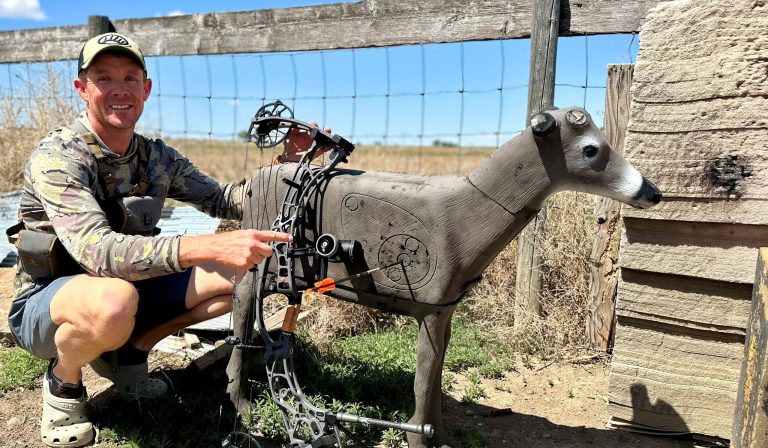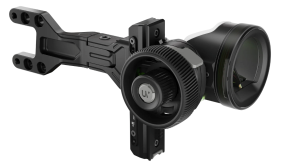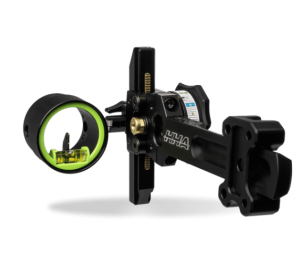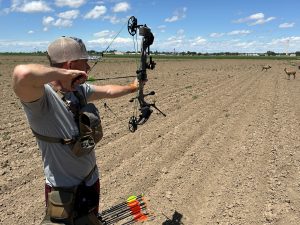My first harvest with a bow was a 54-yard spot-and-stalk pronghorn. At the timer, a five-pin fixed-position TRUGLO sight graced the riser of my Mathews Outback. The compound bow sight had a red 50-yard pin and a green 60-yard pin. I split the two pins and sent an arrow. By the grace of God, that arrow hit home. Honestly, at the time, I had no business shooting that far. However, youth and inexperience mixed with 37 failed stalks prompted me to pull the trigger on my Scott index-finger release. That TRUGLO sight didn’t have tool-less windage or elevation, and nothing about it was micro-adjustable. It didn’t have second- or third-axis adjustment. If it did, I didn’t know enough then to know what either was or how to set them.

Times have changed! In 2021, I dialed my Spot-Hogg Hogg Father Double Pin bow sight to exactly 61.5 yards and sent a SEVR-tipped Easton arrow through the lungs of a Rocky Mountain big horn. The angle was a tick over 20 degrees downhill. It didn’t matter; my third axis was set and confirmed. The sight had all the bells and whistles, and I loved it.
Fast-forward to the present day. In March 2025, I dialed my Spot-Hogg Boonie PM Triple Stack to 61.5 yards (the same distance as my sheep) and put a SEVR Ti 1.5 4-Blade Hybrid through the heart of a Himalayan Tahr. The evolution of the Boonie was beyond that of the Hogg Father. The sight tape wheel was removable for easy tape attachment, allowing me to have different wheel sets up for arrows. Each of the three pins has individual yardage needles; the sight attaches to a Picatinny rail mounted to the bow’s riser to reduce weight and ensure absolute lock-down. I could go on, and later in this article, I will.
Bow sight design has come a long way, and the technologies of modern-day sights are something to marvel at. Still, a bow sight is just a tool—a piece of the pie. The pie is complete with the bow, rest, quiver, arrows, stabilizer, etc. I mention this because bow sights get lots and lots of attention. Today’s sights feature sleek and sexy designs, and though dripping with purposeful technology, the good one’s cost between $400 and $600. Let’s dive in.

What A Compound Bow Sight Is
A bow sight is a tool that mounts to the riser. Modern-day mounting means models with Picatinny, Bridge-Lock, and standard mount systems. The sight has a housing with fiber optic pins that vary in number, orientation (horizontal and vertical), size, and color. Most sight builders offer maximum housing customization.
There are bow sights with a single pin and those with two, three, four, five, and seven-pin designs. There are fixed and movable sights, and any sight worth its salt will have bright fiber optics for maximum low-light performance, second- and third-axis adjustments, and micro-adjust windage and elevation.
What A Compound Bow Sight Is Not
A bow sight is not Harry Potter’s magic wand. A new bow sight won’t make you a better bow shot. If you’re struggling with target panic, buck fever, or need coaching lessons, a fancy-to-do new bow sight will not cure you. I only mention this because the bow sight arena has exploded, and while purposeful and brilliantly designed, many of today’s bow sights sport racy builds that ensure excellent eye appeal.
Five Bow Sights For Your Compound Bow
I’m not branding these bow sights with awards and won’t make them what they aren’t. I have used and tested these bow sights, or have good buddies—archery and bowhunting gurus that I trust—who stand behind them. Do I believe in these sights? Yes! Are they worth dropping your hard-earned greenbacks on? Yes! These are the sights I use, believe in, and/or have first-hand knowledge of.
Spot-Hogg Boonie PM Triple Stack
Shop Lowest Price – Seen at GOHunt 🛒
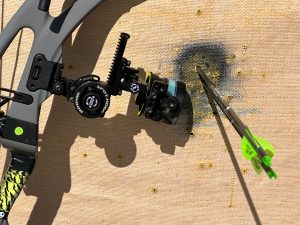
I’ve taken this sight worldwide and never had an issue. If you opt for the Spot-Hogg Boonie PM Triple Stack, you can count on world-class durability and precision. The single set-screw clamp with washer allows direct-to-riser mounting via the PM clamp. Lockdown is immediate and absolute, and once locked down, the Boonie PM isn’t moving. The sight has 1st, 2nd, and 3rd axis adjustments. The yardage wheel is large and removable for easy sight tape addition, and with only two set screws, you can remove the wheel and add a different wheel with a tape dialed for a different arrow setup.
Three pins on vertical bars with individual, adjustable indicator needles ensure precision. Yardage wheel lock-down has been improved, windage adjustment is tool-less, and the rack-and-pinion slider adjustment is silky smooth.
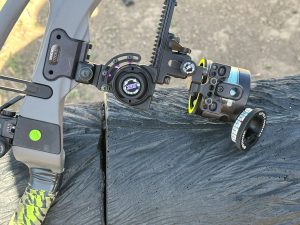
When Spot-Hogg built the Boonie Series—there are multiple models—they went for undeniable durability, maximum functionality, and a sight that helps the archer produce superior accuracy. Mission accomplished! With your Boonie, you get multiple MRT rings to ensure accuracy in any light condition by allowing your eye to better align with the peep sight. Best of all, Boonie sights start under $400. My sight of choice—the PM Triple Stack—costs $479.99.
UltraView UV Slider 2
Shop Lowest Price – Seen at Scheel’s 🛒
After taking a tumble hunting for elk in the mountains, which gave me a bent mounting bar on my original UV Slider, I didn’t think I’d recommend the UV Slider 2. However, this shows I hold zero malice toward the sight maker, and aside from some durability issues that I believe UltraView has remedied, the UV Slider 2 looks to be impressive. I can’t wait to get it into the field on a hunt.
The UV Slider 2 comes in Bridge-Lock, Picatinny, and Direct (standard) mounting options. All sights are under 10 ounces, and the sight comes with RH/LH sight tapes, a travel case, UV Slider 2 No-Light Viz Ring, metal setup tapes, two tape plates, and a hardware kit. Jump on UV’s website to build and customize your Slider 2 however you want.
I love the oversized rubberized yardage wheel with an internal lock/unlock wheel. Patented elevation and windage adjustments are smooth and easy. QuickBreak easily detaches the scope assembly from the rack for transport, a feature I appreciate when I fly with my bow. Of course, the Slider 2 has all the bells and whistles. The hot-swappable cartridges allow you to alter the internal makeup of your sight easily, and the UV Slider 2 has a micro-adjust 1st axis, which also adjusts the 2nd axis. As with all top-end sights, the UV Slider 2 has a micro-adjust 3rd axis. Out the door, the sight will run you around $500.
Dialed PRUF Mover
Shop Lowest Price – Seen at GOHunt 🛒
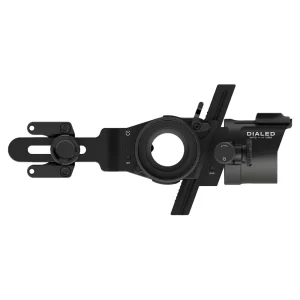
In its third year, Dialed has given bowhunters and target archers some excellent models, but none finer than the 2025 PRUF Mover. I’m a fan of this sight despite its $560 price tag. As with many of today’s flagship sights, the PRUF has multiple mounting options and pin configurations. My current go-to is the PRUF Mover Picatinny with a MAG 3V .010″ pin configuration.
I appreciate the sight’s sleek, lightweight design, and the angled drive system and smaller-sized housing let the shooter get more yardage out of the sight. Dialed added a slider shield to the top of the housing that moves in and out to allow the archer to customize pin brightness in any setting. The yardage wheel is oversized with raised ribs to ensure an easy grip. I’m not a massive fan of the position of the yardage wheel locking lever. Still, the lever is absolute and allows for complete lockdown plus various tension settings.
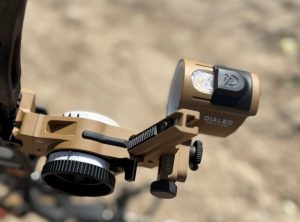
Windage is micro-adjustable, and all three axes’ settings are single screw and labeled, which is an excellent feature. I also like the customizable internal sight ring color options. When you build your bow sight on Dialed’s website, you’ll see an option for MAG Choice. The MAG is the internal makeup of the housing. Pin sizes, like the Boonie and UV 2, are .010 and .019.” Pin configurations are single, triple (horizontal and vertical), and five-pin (horizontal only).
Everything on the bow sight is customizable. I love the top-mounted level bubble; it’s easier to see at full draw. Dual Switch Tape Rings and up to six indicator needles allow for maximum customization, provide exact yardages, and let you tinker. You can display the same tape on both sides or run a pair of different tapes for varying arrow speeds. This sight is a winner.
HHA NYTRX PRO
Shop Lowest Price – Seen at Scheel’s 🛒
HHA has owned the single-pin arena, and though its new-for-2025 NYTRX PRO is available in 1, 2, and 3-pin options, all are set on a single post set on a vertical plane. Mount options are Side, Picatinny, and Dovetail, and I love the green internal housing ring. For many shooters, fluorescent green grabs the eye and helps the shooter quickly acquire the target and put the right pin on it.
The NYTRX PRO showcases a repositioned gear rack for maximum range, tape distance received a boost, and the removable yardage wheel lets you swap between various arrow setups. Shooters can switch—quite easily in fact—between pin configurations, and interchangeable indicators let you match your scope housing. The two-stage windage adjustment (macro and micro) reduces sight-in time. The NYTRX PRO has a new 1st axis adjustment that ensures the sight rail is always traveling level to your bow, thus boosting your accuracy at longer ranges.
NYTRX PRO weights range between 11.8 and 13.8 ounces, cost $520, and offer pin sizes of .010 and .019.” The sight is rigid, durable, and built to handle any hunt or tournament.
AXCEL Driver
Shop Lowest Price – Seen at Scheel’s 🛒
Yes, I’m a fan of the Picatinny mount system. However, if you’re a Mathews shooter, I highly recommend the Bridge-Lock system. I stay away from direct or standard mounts. Yes, they will save you some money, but when you’re spending over $400 on a new bow sight, what’s another $50 or $60?
AXCEL’s Driver is a top-end bow sight that two of my hunting buddies won’t stop raving about. I tested the AXCEL Landslyde and loved it, and the all-new Driver is even better. The Picatinny mount model in a three-pin will run you $500. Unlike the other sights in this roundup, the Driver sports pin sizes of .010, .019, and .029.” Pin color options include Green, Blue, Yellow, and Red.
My buddies rave about the rubber exterior on the oversized wheel that allows for positive hand contact. They also cheer the sight’s rugged yet sleek build, pin brightness, and the sight scale indicator(s) slot so they can be adjusted up and down for a precise setting.
The Driver has metal and stick-on sight tapes; I prefer the metal. I appreciate the not-too-big housing and that the scope receiver is perpendicular to the elevation bar. This build means you can level the first and second axes by adjusting only the first axis. The sight also has a third-axis setting; from what I can tell, it is one of the best sight options for 2025.
FAQs
Do I have to spend $400 or more on a bow sight?
No. Not at all. The purpose of this roundup is to inform you about the very best bow sights on the market. You can get an incredible bow sight for under $200.
What is a great bow sight for under $200?
My youngest son shoots Trophy Ridge’s HotWire sight and loves it. I also like Black Gold’s Ascent and Redline’s RL Torch Dovetail 4 Pin.
How important are the axes settings on a bow sight?
Critical! The first axis runs parallel to the ground. The second axis is the vertical alignment of the pins in the housing to the bow’s riser and the archer’s line of sight. A sight’s third axis runs parallel to your body through the center of your sight. If the bow is tipped to 45 degrees and the bubble remains centered, the bow’s third axis setting is properly set. The third axis is critical for accuracy when shooting at uphill and downhill angles.
Final Thoughts
Bow sight choice, like all things in archery, is personal. Please don’t pick a sight because it looks ultra cool or because you can trick it out with different colored yardage wheels and housing rings. Sure, those things are incredible and look cool, and many amazing sights offer them. If price is a concern, be sure to buy around Prime Time or through the best black friday hunting deals. The most important thing is that the sight is functional, durable, and helps you put carbon and broadheads where you want it to go.
Per our affiliate disclosure, we may earn revenue from the products available on this page. To learn more about how we test gear, click here.





